|
Fabulous Blenko Glass
By Deborah
Allen
I bought my first
piece of Blenko glass in 1982 from a local retail store. It
was a bowl from the West Virginia landscape series called "Big
Sky." What drew me to it were the colors that shaded from the
sky blue of the rim to the pale green of the mountains molded
into the base. From the tag I learned that the Blenko Glass
Co., Inc. was located in "Milton, W.V." and that my bowl was
handmade. I got Blenko's catalog and discovered numerous
designs I wanted and that many vibrant colors were
available.
Twenty-one years and
361 pieces later, I'm still enchanted by Blenko's products.
The first thing I notice is the color. Blenko Glass Co. was
founded in 1921 by William John Blenko to produce stained
glass for architecture. Mr. Blenko had training as a chemist
and eventually had over 1,200 formulas for glass colors. When
the company added tablewares to its line in the 1930s to stay
in business during the Depression, it used the same glowing
colors for drinkware, vases, decanters, bowls, etc. To this
day, the colors of Blenko stand out in a crowded antique mall
or in a retail display.
While I don't think
I've seen all 1,200+ variations, I have been able to collect a
wide range of reds, yellows, purples, greens, blues, ambers,
shaded effects, and one-of-a-kind colors. It is possible to
find lilac, amethyst, plum, orchid and violet for purples.
Chartreuse, emerald, grass, olive, sea, and peridot are
available in green. Blues are numerous: Persian, azure,
turquoise (also called "Blenko Blue"), cobalt, peacock, and
sky. Ambers range from deep honey through wheat to topaz.
Blenko's ruby is deep, unmistakable red. Yellow, or jonquil,
will be bright, but can be transparent, translucent, almost
opalescent, or opaque.
"Big Sky," "Blue Top
Mountain" and "Desert Green" are shaded effects that go from
blues to greens to ambers. There are several one-of-kind
colors that Blenko used for varying lengths of time, sometimes
just a year. Rose, a gorgeous pink with lavender undertones,
was available in 1963 and 1964. Charcoal was available longer,
but semi-opaque white "Rialto" was made for one year -1960.
Alpine blue, a blue/green combination was used for a short
period in 1993.
Another great
strength of Blenko lies in its designs. In 1947, Mr. W.H.
Blenko, Sr. hired his first professional designer, Winslow
Anderson, who stayed until 1953. I have 18 of Mr. Anderson's
designs, and I want dozens more. All of his designs are
clever, sleek and rely on arresting shapes rather than
"ruffles and flourishes" for their appeal. His bent neck
decanter won the Museum of Modern Art's "Good Design Award" in
1950. As a matter of fact, the one piece I yearn for most, my
Holy Grail as it were, is one of Mr. Anderson's crystal
glasses with an attached ashtray.
In April of 2000, I
was lucky enough to spend two hours with Mr. Anderson at his
home. He told me how he came to design the ashtray glasses. He
noticed at cocktail parties that with a plate in one hand, a
glass in another and a lighted cigarette, there was no place
to rest a cigarette or dispose of ashes. Hence, the glass with
attached ashtray. Practical but fragile, apparently, because
in 21 years of collecting, I've never seen one for
sale.
After such a solid
and imaginative start, there have been seven other designers
at Blenko. They are Wayne Husted (19531963), Joel Philip
Myers (1963 1970), John Nickerson (19701975), Don
Shepherd (19751988), Hank Adams (19881994), Chris
Gibbons (19941995), and Matt Carter (1995 2002).
Each of them contributed his own artistic vision to Blenko's
products. From Anderson to Carter, an atmosphere of
originality and daring in design has been encouraged. The
result is a radiant array of glassware.
Intense color and
striking design make Blenko stand out. However, the company
does use labels to identify its glass: a silver foil hand
shape that reads "Blenko Handcraft" (until 1982); a square
reading "Blenko Handmade" with a silver B and an orange dot
(until 1990s); and now an oval with a small silver hand in the
center reading "Blenko Handcraft" surrounded by clear border
saying, "Made in USA."
Until recently,
permanent marks had been used only in 1959 and 1960 when
"Blenko" in block letters was sandblasted on the base of the
piece. This can be hard to see, and all letters may not be
legible, but it serves as instant identification and dating.
In 2002, Blenko started sandblasting the year, its name and a
hand mark on the bottom of each piece. But what if there is no
label or sandblasted mark on the glass?
If the piece is
unmarked, I start with the color. Is it a color Blenko made?
Is it bright or intense enough? Then I pick up the piece to
check its weight. Blenko tends to be heavy for its size. I
also look for a rough pontil mark. Some Blenko is molded with
a smooth base; those shapes I just have to remember. If the
color, weight and pontil mark are right, then it's a question
of shape.
Even after years of
handling Blenko, studying the books, and looking at the pieces
in museums, I'm not always right. I bought a decanter I was
sure was Blenko, but it turned out to be a Rainbow Glass Co.
piece. In order to specialize, it's necessary to know what's
not, as well as what is, Blenko.
Because there used to
be hundreds of glass factories in West Virginia that often
influenced each other's designs, it is essential to
differentiate Blenko from all the rest. For many years, only
one book was available, Blenko Glass: 1930-1953 by Eason Eige
and Rick Wilson published in 1987, but now out of print.
Fortunately, Dr. Leslie Pina wrote a series of books that are
the bibles for identification: Blenko Glass: 1962-1971
Catalogs; Blenko: Cool '50s & '60s Glass; Blenko 1972-1983
Catalogs; Blenko Catalogs: Then and Now: 1959-1961,
1984-2001.
Other books with
designs from West Virginia glass companies are useful for
comparison to Blenko. Collecting Crackle Glass by Judy Alford
has catalog pages for Kanawha Glass Co. and Rainbow Art Glass
Co., as well as photos of Pilgrim, Viking and other wares
similar to Blenko. Dr. Pina has two helpful books: Crackle
Glass in Color: Depression to '70s and Crackle Glass Too:
1950-2000. For the serious collector, buying at least the
catalog reprints is a must. My copies go with me on every
hunt.
I have been able to
antique mostly in the Southeast and West Virginia. The Blenko
I see most often is the smaller pieces, such as the
double-spouted water bottles, pitchers, vases with ruffled
tops or applied leaves, free-form ashtrays and paperweights.
Decanters are scarcer now than they used to be, and condition
is a problem. Blenko is easily marked by liquid, so with vases
and decanters, watch for cloudiness.
What about cost? On
the Internet, prices at auction can be high, though I've
gotten some good deals. In the shops or antique malls, the
price depends on the dealer's knowledge and on the presence or
absence of a label. Price guides can be misleading, so I use
them as only the most general guideline. The most amusing
price I ever paid for a piece of Blenko was one quarter of a
chocolate cake. Fair market value can be whatever the parties
involved decide it is!
Rarity needs to be
considered. If I find a piece I've never seen before or have
seen only once or twice in 21 years, even if it's more than I
would normally pay, I'll go ahead and buy it. Collectors have
to be realistic about availability as well as cost.
The most popular
shapes seem to be decanters of any size and the huge,
architectural floor bottles or vases, which can sell for
hundreds of dollars. The most popular colors are the intense
jewel tones. Rose is rare, lovely and commands a high
price.
I have been told that
honey/topaz and the paler greens don't sell as well, but
Blenko does such a beautiful job even with them that, if I
don't have the shape, I will buy them anyway. Because Blenko's
colors are so much of its appeal, crystal is the least
popular. I only buy crystal Blenko if I love the shape, and
the piece was made only in crystal.
Blenko can be found
in all the usual places. Antique shops and malls usually have
a piece or two. Occasionally, Blenko is mentioned in an
auction list. It's available on the Internet. Because the
factory is still in business, Blenko can be found at
department stores and gift shops. As we move deeper into the
new century, older Blenko from the '30s through the '60s is
showing up at glass shows and sales.
Two of my older
pieces are teal candlesticks from the late '30s or early '40s
that I found at the Peach State Depression Glass Club's show.
Since I'm a member of the club, I'm involved with the show
every year. The show and sale this year is July 26-27 at the
Cobb County Civic Center at 548 South Marietta Parkway,
Marietta, Ga. (770-528-8450). It will feature Depression and
elegant glass from the '40s, '50s, '60s, and Fenton through
the '80s. Glass repair and cloudy glass cleaning will be
available, as will glass identification. The special guests
are Gene Florence and Margaret Whitmyer, both published
authors and experts on collectible glass.
Collecting Blenko has
enriched my life. Whatever you may collect, my best wish for
you would be the same pleasure as I've had over the last 21
years.
2003
|
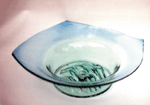
"Big Sky" bowl, 1982, Don Shepherd, 14 1/2" x
15", $80-$125.
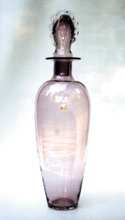
Orchid color decanter, 1990s, Hank Adams, 25",
$90-$125.
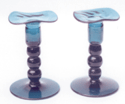
Teal candlesticks, 1930s Blenko design, 6"
$40-$75 for the pair.
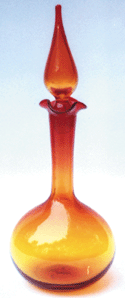
Amberina color decanter, 1930s, 13 1/2",
$30-$60.
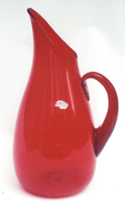
Red pitcher, 1950s, Winslow Anderson, 14",
$75-$125.
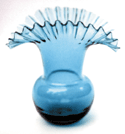
Ruffle top vase, 1930s Blenko design, 7 7/8"
tall, $30-$50.
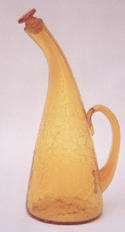
Yellow crackle, bent neck decanter, 1950,
Winslow Anderson, 13", $150-$200.
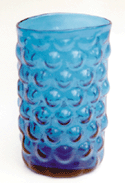
Turquoise blue (Blenko blue), bubble vase,
1959-1960, 9 1/2" tall, $75-$125.
|